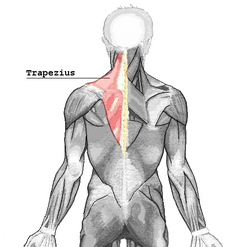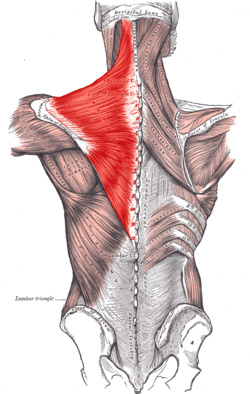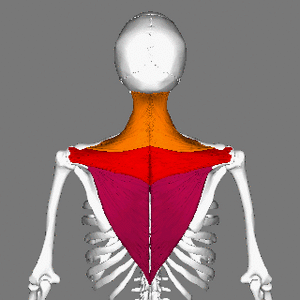Trapezius facts for kids
Quick facts for kids Trapezius |
|
|---|---|
 |
|
| The trapezius muscle (plural: trapezii) is a surface muscle of back, shown in red above and below | |
 |
|
| Latin | Musculus trapezius |
| Artery | superficial branch of transverse cervical artery or superficial cervical artery |
| Nerve | accessory nerve (motor) cervical spinal nerves C3 and C4 (motor and sensation) |
The trapezius is a big muscle on your back. It's shaped a bit like a diamond or a kite. It stretches from the back of your head down to the middle of your spine and out to your shoulder blade. This muscle helps you move your shoulder blade and supports your arm.
The trapezius has three main parts. The upper part helps hold up your arm. The middle part pulls your shoulder blade back. The lower part helps move your shoulder blade down and rotate it.
Contents
What's in a Name?
The word "trapezius" comes from the muscle's shape. It looks like a trapezoid, which is a four-sided shape with at least one pair of parallel sides. Sometimes, in older books or when talking about animals, you might hear it called "spinotrapezius."
How the Trapezius is Built
The trapezius muscle is made of three groups of fibers, or muscle strands, that work together.
Upper Trapezius Fibers
The upper fibers start at the back of your head, near the base of your skull, and from a strong band of tissue in your neck called the Nuchal ligament. They go downwards and outwards to connect to the outer part of your clavicle (collarbone).
Middle Trapezius Fibers
The middle fibers start from the bones in your upper neck (C7) and upper back (T1-T3). They go sideways to connect to a part of your scapula (shoulder blade) called the acromion and the ridge on your shoulder blade.
Lower Trapezius Fibers
The lower fibers start from the bones in your middle and lower back (T4-T12). They go upwards and outwards, coming together to form a flat, strong tendon. This tendon then connects to a small bump on your shoulder blade.
You can feel your upper trapezius muscles working! Try holding something heavy in one hand in front of you. With your other hand, touch the area between your shoulder and neck. You'll feel the muscle get tight.
How Nerves Control the Trapezius
Your muscles need nerves to tell them what to do. The main nerve that controls the trapezius muscle is called the accessory nerve. This nerve sends signals that make the muscle move.
Other nerves from your neck (C3 and C4 cervical spinal nerves) also help. They send signals for movement and also for feeling things like pain or knowing where your body parts are (this is called proprioception).
What the Trapezius Does
The trapezius muscle has two main jobs. It can move your shoulder blade when your spine is still. Or, it can move your spine when your shoulder blade is still. Its most important job is to help your shoulder blade move and stay steady.
Moving Your Shoulder Blade
Each part of the trapezius helps your shoulder blade move in different ways:
- The upper fibers lift your shoulder blade up.
- The middle fibers pull your shoulder blade back.
- The lower fibers pull your shoulder blade down.
The upper and lower fibers also help your shoulder blade rotate upwards. This is important for movements like lifting your arm above your head. They work with another muscle called the serratus anterior muscle to do this.
For example, when you do an overhead press (lifting weights above your head), your trapezius muscles are very active. The upper and lower fibers also help the middle fibers pull your shoulder blades together.
The trapezius also helps you lift your arm more than 90 degrees. If the nerve controlling it (cranial nerve XI) is hurt, it can be hard to lift your arm high.
Moving Your Spine
When your shoulder blades are held still, both sides of the trapezius muscle can work together to help you extend, or bend back, your neck.
When the Trapezius Has Problems
Sometimes, the trapezius muscle doesn't work as it should. This can lead to problems with how your shoulder blade moves.
Trapezius Palsy
If the spinal accessory nerve (the main nerve for the trapezius) gets damaged, it can cause something called trapezius palsy. This means you might have trouble moving your arm, and your shoulder might droop. You could also feel pain in your shoulder and neck.
Muscle Weakness
The trapezius muscle can also be affected by certain muscle diseases. For example, in a condition called facioscapulohumeral muscular dystrophy (FSHD), the lower and middle parts of the trapezius often become weak first.
Underdevelopment
In very rare cases, someone might have an underdeveloped or even missing trapezius muscle. This can cause neck pain and make it hard to control the shoulder blade.
Keeping Your Trapezius Strong
You can do exercises to make your trapezius muscles stronger!
- To strengthen the upper part of your trapezius, you can do exercises where you lift your shoulders up, like a shoulder shrug.
- To strengthen the middle fibers, you can do exercises that pull your shoulder blades together.
- To strengthen the lower part, you can do exercises where you pull your shoulder blades downwards, keeping your arms mostly straight.
The trapezius is also very important for throwing things, working with your deltoid muscle and rotator cuff muscles.
See also
 In Spanish: Músculo trapecio para niños
In Spanish: Músculo trapecio para niños


